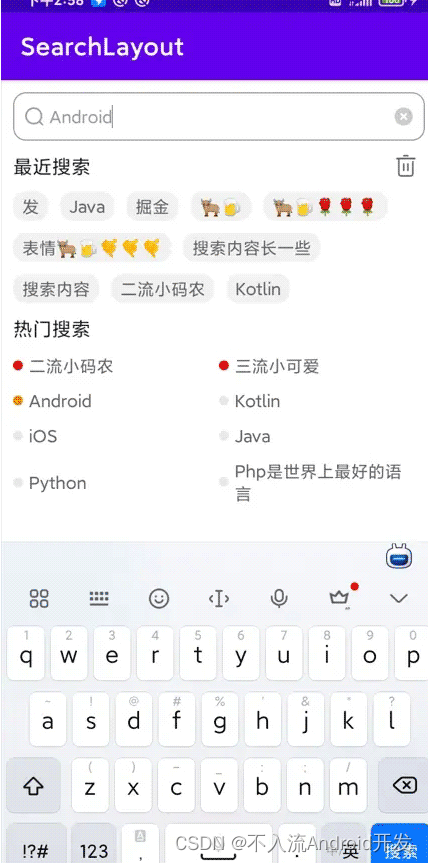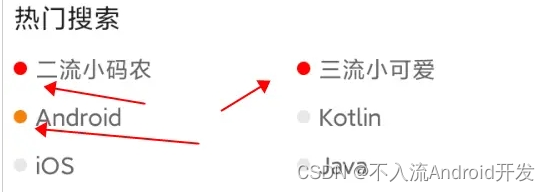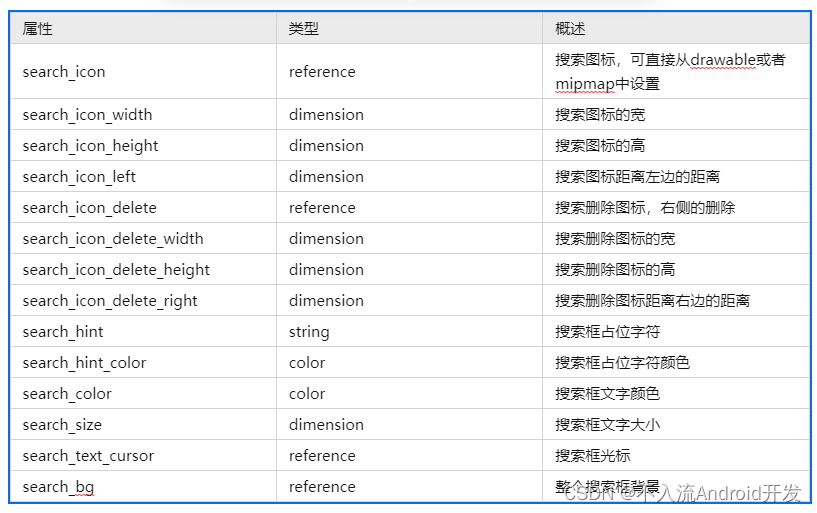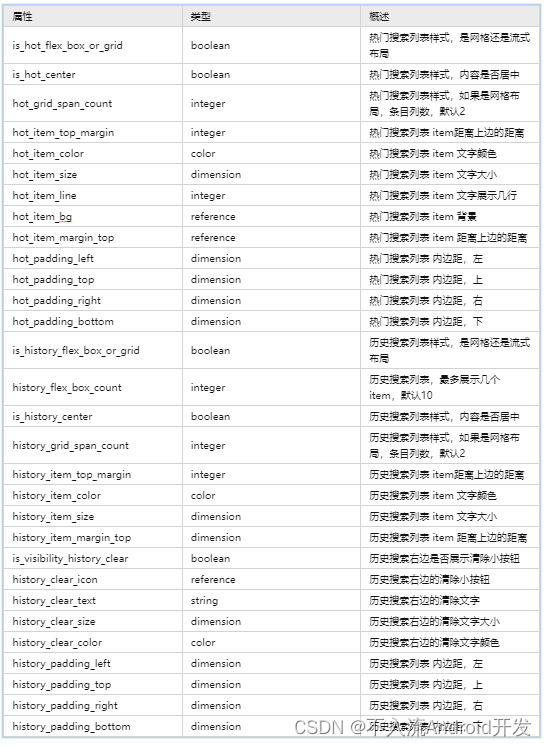Android开发自定义搜索框实现源码详解

今天我带来了一个非常实用的自定义搜索框,包括搜索框、热门搜索列表、最近常用的搜索列表等功能也差不多,可以直接重用,会大大节省你的开发时间有一点要负责任的告诉你,这个的实现是一个非常简单的自定义组合视图除了介绍之外,我还会和大家分享具体的实现过程。
一,实现效果
效果很常见,就是平常需求中的效果,上面是搜索框,下面是最近和热门搜索列表,为了方便大家在实际需求中使用,配置了很多属性,也进行了上下控件的拆分,也就是上边搜索框和下面的搜索列表的拆分,可以按需进行使用。

二、快速使用及属性介绍
快速使用
目前已经发布至远程Maven,大家可以进行远程依赖使用。
1、在你的根项目下的build.gradle文件下,引入maven。
allprojects {repositories {maven { url "https://gitee.com/AbnerAndroid/almighty/raw/master" }}
}
2、在你需要使用的Module中build.gradle文件下,引入依赖。
dependencies {implementation 'com.vip:search:1.0.0'
}
具体代码
1、xml中引入SearchLayout(搜索框)和SearchList(搜索列表),在实际开发中,根据需求可选择使用,二者是互不关联的。
<?xml version="1.0" encoding="utf-8"?>
<androidx.constraintlayout.widget.ConstraintLayout xmlns:android="http://schemas.android.com/apk/res/android"xmlns:app="http://schemas.android.com/apk/res-auto"xmlns:tools="http://schemas.android.com/tools"android:layout_width="match_parent"android:layout_height="match_parent"android:paddingLeft="10dp"android:paddingRight="10dp"tools:context=".MainActivity"><com.vip.search.SearchLayoutandroid:id="@+id/search_layout"android:layout_width="match_parent"android:layout_height="40dp"android:layout_marginTop="10dp"app:layout_constraintLeft_toLeftOf="parent"app:layout_constraintTop_toTopOf="parent"app:search_bg="@drawable/shape_stroke_10" /><com.vip.search.SearchListandroid:id="@+id/search_list"android:layout_width="match_parent"android:layout_height="wrap_content"android:layout_marginTop="10dp"app:is_hot_flex_box_or_grid="true"app:is_visibility_history_clear="true"app:layout_constraintTop_toBottomOf="@id/search_layout" />
</androidx.constraintlayout.widget.ConstraintLayout>
2、代码逻辑,以下是测试代码,如用到实际项目,请以实际项目获取控件为主。
class MainActivity : AppCompatActivity() {override fun onCreate(savedInstanceState: Bundle?) {super.onCreate(savedInstanceState)setContentView(R.layout.activity_main)val searchLayout = findViewById<SearchLayout>(R.id.search_layout)val searchList = findViewById<SearchList>(R.id.search_list)searchLayout.setOnTextSearchListener({//搜索内容改变}, {//软键盘点击了搜索searchList.doSearchContent(it)})//设置用于测试的热门搜索列表searchList.setHotList(getHotList())//热门搜索条目点击事件searchList.setOnHotItemClickListener { s, i ->Toast.makeText(this, s, Toast.LENGTH_SHORT).show()}//历史搜索条目点击事件searchList.setOnHistoryItemClickListener { s, i ->Toast.makeText(this, s, Toast.LENGTH_SHORT).show()}}/
* AUTHOR:AbnerMing
* INTRODUCE:模拟热门搜索列表
*/private val mTestHotList = arrayListOf("二流小码农", "三流小可爱", "Android","Kotlin", "iOS", "Java", "Python", "Php是世界上最好的语言")private fun getHotList(): ArrayList<SearchBean> {return ArrayList<SearchBean>().apply {mTestHotList.forEachIndexed { index, s ->val bean = SearchBean()bean.content = sbean.isShowLeftIcon = trueval drawable: Drawable? = if (index < 2) {ContextCompat.getDrawable(this@MainActivity, R.drawable.shape_circle_select)} else if (index == 2) {ContextCompat.getDrawable(this@MainActivity, R.drawable.shape_circle_ordinary)} else {ContextCompat.getDrawable(this@MainActivity, R.drawable.shape_circle_normal)}drawable?.setBounds(0, 0, drawable.minimumWidth, drawable.minimumHeight)bean.leftIcon = drawableadd(bean)}}}
}
主要方法介绍
1、搜索框监听
拿到searchLayout控件之后,调用setOnTextSearchListener方法即可,第一个方法是搜索内容发生变化会回调,第二个方法是,点击了软键盘的搜索按钮会回调,如果要在最近搜索里展示,直接调用doSearchContent方法即可。
searchLayout.setOnTextSearchListener({//搜索内容改变}, {//软键盘点击了搜索searchList.doSearchContent(it)
})
2、搜索列表点击事件
热门搜索调用setOnHotItemClickListener方法,历史搜索也就是最近搜索调用setOnHistoryItemClickListener方法,都是两个参数,第一个是文本内容,第二个是索引,也就是点的是哪一个。
//热门搜索条目点击事件
searchList.setOnHotItemClickListener { s, i ->Toast.makeText(this, s, Toast.LENGTH_SHORT).show()
}
//历史搜索条目点击事件
searchList.setOnHistoryItemClickListener { s, i ->Toast.makeText(this, s, Toast.LENGTH_SHORT).show()
}
3、改变最近(历史)搜索item背景
有的老铁说了,默认的背景我不喜欢,能否可以动态设置,必须能!

设置背景,通过setHistoryItemBg方法。
searchList.setHistoryItemBg(R.drawable.shape_solid_d43c3c_10)
效果展示

4、动态设置热门搜索热度
可能在很多需求中,需要展示几个热度,有的是按照颜色区分,如下图:

实现起来很简单,在设置热门列表(setHotList)的时候,针对传递的对象设置leftIcon即可。测试代码如下:
private fun getHotList(): ArrayList<SearchBean> {return ArrayList<SearchBean>().apply {mTestHotList.forEachIndexed { index, s ->val bean = SearchBean()bean.content = sbean.isShowLeftIcon = trueval drawable: Drawable? = if (index < 2) {ContextCompat.getDrawable(this@MainActivity, R.drawable.shape_circle_select)} else if (index == 2) {ContextCompat.getDrawable(this@MainActivity, R.drawable.shape_circle_ordinary)} else {ContextCompat.getDrawable(this@MainActivity, R.drawable.shape_circle_normal)}drawable?.setBounds(0, 0, drawable.minimumWidth, drawable.minimumHeight)bean.leftIcon = drawableadd(bean)}}}
具体的哪个数据展示什么颜色,直接设置即可,想怎么展示就怎么展示。当然了除了展示不同的热度之外,还有一些其他的变量,isShowLeftIcon为是否展示文字左边的icon,textColor为当前文字的颜色,根据不同的颜色,我们也可以实现下面的效果。

属性介绍
为了让功能灵活多变,也为了满足更多的需求样式,目前自定义了很多属性,大家可以按自己的需要进行设置,或者直接去GitHub中下载源码更改也可以。
SearchLayout(搜索框属性)

SearchList(搜索列表属性)

三、具体代码实现
关于这个组合View的实现方式,我是分为了两个View,大家在上边的使用中应该也看到了,一个是搜索框SearchLayout,一个是搜索框下面的搜索列表展示SearchList,开头就阐述了,没啥技术含量,简单的罗列下代码实现吧。
SearchLayout是一个组合View,中间是一个EditText,左右两边是一个ImageView,也就是搜索图标和删除图标,如下图:

SearchLayout本身没有啥要说的,无非就是把View组合到了一起,在开发的时候,既然要给别人使用,那么就要拓展出很多的动态属性或者方法出来,这是很重要的,所以,在封装的时候,自定义属性无比的重要,需要精确和认真,这一块没啥好说的,有一点需要注意,也就是EditText绑定软键盘搜索,除了设置属性android:imeOptions=“actionSearch”,也要设置,android:singleLine=“true”,方可生效。
SearchList其实也没啥好说的,也是一个组合View,使用的是上下两个RecyclerView来实现的,至于流失布局,采用的是google提供的flexbox,设置布局管理器即可。
recyclerView.layoutManager = FlexboxLayoutManager(mContext)
除了这个之外,可能需要阐述的也就是最近搜索的存储机制了,存储呢,Android中提供了很多的存储方式,比如数据库,SharedPreferences,SD卡,还有DataStore,MMKV等,无论哪一种吧,选择适合的即可,这个开源中,不想引入其他的三方了,直接使用的是SharedPreferences。
具体的实现方式,把搜索的内容,转成json串,以json串的形式进行存储,这里借助了原生的JSONArray和JSONObject。流程就是,触发搜索内容后,先从SharedPreferences取出之前存储的内容,放到JSONArray中,当前搜索内容如果存在JSONArray中,那边就要执行删除原来的,再把新的内容插入到第一个的位置,如果不存在JSONArray中,直接添加即可,随后再转成字符串存储即可。
当然了,一般在正常的需求开发中,最近搜索列表肯定不是无限展示的,都有固定的展示个数,比如10个,比如15个,所以,当超过指定的个数,也就是指定的阀门后,就要执行删除的操作。
val searchHistory = getSearchHistory()
if (!TextUtils.isEmpty(it)) {val jsonArray: JSONArray = if (TextUtils.isEmpty(searchHistory)) {JSONArray()} else {JSONArray(searchHistory)}val json = JSONObject()json.put("content", it)//如果出现了一样的,删除后,加到第一个var isEqual = falsevar equalPosition = 0for (i in 0 until jsonArray.length()) {val item = jsonArray.getJSONObject(i)val content = item.getString("content")if (it == content) {isEqual = trueequalPosition = ibreak}}//有一样的if (isEqual) {jsonArray.remove(equalPosition)} else {//超过了指定的阀门之后,就不在扩充if (jsonArray.length() >= mHistoryListSize) {jsonArray.remove(0)}}jsonArray.put(json)SearchSharedPreUtils.put(mContext!!, "search_history", jsonArray.toString())
}
getSearchHistory()?.let {eachSearchHistory(it)
}
//两个有一个不为空,展示
if (!TextUtils.isEmpty(it) || !TextUtils.isEmpty(searchHistory)) {showOrHideHistoryLayout(View.VISIBLE)
当然了,存储的逻辑,有很多的实现的方式,这里并不是最优的,只是提供了一种思路,大家可以按照自己的方式来操作。
搜索列表,无论是热门还是最近的搜索列表,均支持网格和流失布局形式展示,大家看属性相关介绍中即可。这个搜索框本身就是很简单的效果还有代码,大家直接看源码或文中介绍即可,就不多赘述了!希望这篇文章内容能给大家提供帮助。
您可能感兴趣的学习资料:
Android进阶学习笔记:docs.qq.com/doc/DWHFqVHBMVEJPWUx
Android工程师面试题钢:docs.qq.com/doc/DWGZIRFh5VEtYWE1D
Android音视频入门到高阶学习笔记:docs.qq.com/doc/DWFFWZHNPTHZVdHFX
Android开源框架设计思想解读:docs.qq.com/doc/DWHlGYUdseVhsSUda


